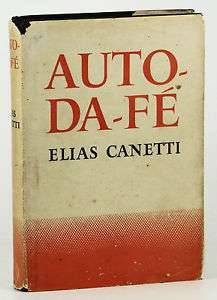Auto-da-Fé (novel)
 1st English language edition, 1946 | |
| Author | Elias Canetti |
|---|---|
| Original title | Die Blendung |
| Translator | C. V. Wedgwood |
| Country | Austria |
| Language | German |
| Published |
|
| Media type | |
| Pages | 464[1] |
Auto da Fé (original title Die Blendung, "The Blinding") is a 1935 novel by Elias Canetti; the title of the English translation (by C. V. Wedgwood, 1946) refers to the burning of heretics by the Inquisition.
Publication history
The book manuscript was finished in 1931, and the book was published in 1935, by Herbert Reichner in Vienna (Canetti's hometown at that time). It is Canetti's first publication.
In 1943 Canetti got an offer to publish the book in English with Jonathan Cape, but it was decided to delay publication until after the war. It was eventually released in 1946. The book did not become widely known until after the worldwide success of Canetti's Crowds and Power (1960). Jonathan Spence observes that "there is nothing discreet, chaste, or high minded about the finest and wildest of all fictions that centre on a student of China, Canetti's Auto-da-fe." [2]
Plot and themes
The protagonist is Herr Doktor Peter Kien, a middle-aged philologist and Sinologist, uninterested in human interaction or sex, content with his monkish, highly disciplined life in his book-lined apartment in Vienna.
He himself was the owner of the most important private library in the whole of this great city. He carried a minute portion of it with him wherever he went. His passion for it, the only one which he had permitted himself during a life of austere and exacting study, moved him to take special precautions. Books, even bad ones, tempted him easily into making a purchase. Fortunately, the great number of the book shops did not open until after eight o'clock.[3]
Kien is absorbed in his studies of Chinese and shuns social and physical contacts. He is almost obsessive-compulsive in his efforts to avoid contamination, and much of the book is a comedy of his being thrown into close contact with a world that he fears, and doesn't wholly understand: "You draw closer to truth by shutting yourself off from mankind" (Canetti, 15).
He impulsively marries his ignorant housekeeper of eight years, Therese Krumbholz, imagining that she will help keep his library safe. But within days of marriage, the two enter a violent and divided existence. Kien becomes deeply agitated when cut off from three-quarters of his library to accommodate a separate living space for his bride. Ultimately she forces him out entirely. He is deeply bereaved, since to him the books are more alive than people:
Books have no life; they lack feeling maybe, and perhaps cannot feel pain, as animals and even plants feel pain. But what proof have we that inorganic objects can feel no pain? Who knows if a book may not yearn for other books, its companions of many years, in some way strange to us and therefore never yet perceived?" (Canetti, 67). [4]
Kien descends to the depths of society, meeting the dwarf Fischerle, and the blacksmith Gene, who is the cause of his demise. Kien's brother, Georges Kien, a psychiatrist, tries in vain to cure him, perhaps reflective of the author's antagonistic stance toward Freudian psychoanalysis. Canetti's friend, the sculptor Fritz Wotruba, felt that the character was modeled on Canetti's brother Nessim, who at the time lived in France, worked for Polydor Records and was an impresario for French chanson through the nightclub he ran there. "Hadn't I, he asked me, gone wrong out of love for my younger brother, whom I had told him about? No one, he insisted, could have so many skins; I had constructed an ideal character; what a writer does in his books, Georges Kien did in his life ...".[5]
Ultimately, his marriage—intended to protect both himself and his library—destroys them instead, in the conflagration alluded to by the English-language title, Auto-da-Fe.
Bibliography
- Elias Canetti, Auto-da-Fe. Translator C.V. Wedgwood. NY: Farrar, Straus, and Giroux, 1998
- William Collins Donahue, The End of Modernism: Elias Canetti’s Auto-da-Fé (University of North Carolina Press, 2001)
References
- ↑ Google Books: Die Blendung. Auto Da Fé ... Translated ... by C.V. Wedgwood
- ↑ "Twentieth Century Chinese Fictions," in Robin Winks, ed., Asia in Western Fiction (Manchester University Press, 1990), 112
- ↑ Elias Canetti, Auto da Fé, Jonathan Cape, 1971, p. 11
- ↑ Canetti, p. 67
- ↑ From Elias Canetti, Das Augenspiel: Lebensgeschichte 1931-1937 (1985); translated as The Play of the Eyes (New York: Farrar, Straus & Giroux, 1987).